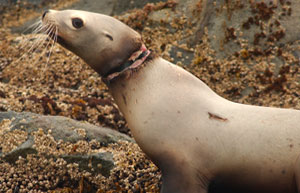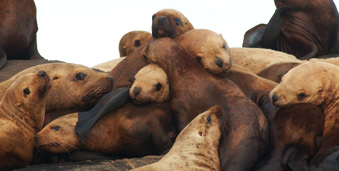Northern (Steller) Sea Lion
The Northern Sea Lion is also called the Steller sea lion, named for naturalist Georg Wilhelm Steller, who described them in 1741. Steller discovered six specis of birds and mammals in 1741. Of those six, two are extinct (Steller's sea cow and the spectacled cormorant) and three are endangered or threatened (Steller's eider, Steller's sea eagle, and Steller's sea lion).
Northern sea lions are often confused with California sea lions, but are much larger and have lighter colored fur. They are found in North Pacific coastal waters from central California to the Kuril Islands north of Japan; the highest concentration of rookeries are found in the Gulf of Alaska and the Aleutian Islands.
Current threats to Steller sea lions
- boat strikes
- contaminants, pollution
- habitat degradation
- illegal hunting, shooting
- offshore oil and gas exploration
- fisheries
 Direct fishery impacts due to fishing gear (drift and set gillnets, longlines, trawls) that entangle, hook, and injure.
Direct fishery impacts due to fishing gear (drift and set gillnets, longlines, trawls) that entangle, hook, and injure.
Photo credit: Alaska Fisheries- Indirect fishery impacts due to competition for food resources and modifications to critical habitat by fishing activities.
In 1960, Steller sea lion population worldwide was estimated between 240,000 to 300,000, but by 2000, their global population had dropped to about 85,000. There are two Distinct Population Segments (DPS), western and eastern. The eastern DPS was delisted under the Endangered Species Act (ESA) in 1990, but their U.S. federal status is listed as threatened.
Protective zones, catch/harvest limits, various procedures and other measures have been implemented around major haul-outs and rookeries in order to safeguard their critical habitat. The IUCN Red List of Threatened Species considers this species to be Endangered.
 The cause of their significant decline is unknown. One theory is that food resources declined due to commercial fisheries, indicated by multiple reports including an official US government Biological Opinion in 1998. Climate change also a threat.
The cause of their significant decline is unknown. One theory is that food resources declined due to commercial fisheries, indicated by multiple reports including an official US government Biological Opinion in 1998. Climate change also a threat.
Quick facts
- Steller sea lions are the largest members of the Otariid (eared seal) family.
- Average lifepan is 20 - 30 years.
- They are near the top of the marine food chain, but vulnerable to orca and sharks.
- They can be found from as far south as California to northern Japan.
- Steller sea lions exhibit sexual dimorphism, which means there is a distinct difference in size or appearance between the sexes of an animal. Adult males may be up to 10 - 11 feet long and weight up to 2,500 pounds while females reach 9.5 feet long and weigh up to 770 pounds. Males have much wider chests, necks, and general forebody structure as well as broader, higher foreheads, flatter snouts and darker, more pronounced fur around their necks, giving them somewhat of a maned appearance..
- Adult coats are light blonde to reddish brown, slightly darker on the chest and abdomen.
- Both sexes have long whitish whiskers on their muzzle.
- Their fur molts every year, meaning that their fur is shed and replaced with new fur each year.
- Unlike "true" seals, their flippers are hairless and black with short claws rather than fur covered with long claws, they can turn their hind flippers forward for walking, and and they have ears with flaps instead of an ear hole.
- Steller sea lions forage near shore as well as out in the open ocean.
- They can travel long distances in a season and can dive to 1,300 feet.
- They are opportunistic predators, foraging and feeding primarily at night on a wide variety of fishes, bivalves (oysters, clams, mussels, and scallops), cephalopods (octopuses or squid), and gastropods (snails and slugs).
- Males become sexually mature between 3 and 8 years of age, but normally are not large enough to establish and defend a rookery territory for breeding until 9 or 10. Females usually being reproducing around 4 to 6 years of age, giving birth to a signle pup each year.
- At birth, pups are about 3.3 feet long and weigh between 35 - 50 pounds and are dark brown to black for several months.
National Marine Mammal Laboratory
Dr. Tom Gelatt explains how NOAA Fisheries scientists are working to protect and study threatened Steller sea lions.
Learn more about current efforts...
NMML Research - Population Decline
Population estimation - 2012
Sources:
Clover, Charles. The End of the Line: How Overfishing Is Changing the World and What We Eat. London: Ebury, 2004. Print.
Loughlin, Thomas R., Michael A. Perez, and Richard L. Merrick. "Eumetopias Jubatus." Mammalian Species 283 (1987): 1. Web."National Marine Mammal Laboratory." National Marine Mammal Laboratory. Web. 17 July 2015.
"NOAA Fisheries Alaska." Delisting of the Eastern Distinct Population Segment of the Steller Sea Lion. N.p., n.d. Web. 17 July 2015. http://alaskafisheries.noaa.gov/protectedresources/stellers/edps/status.htm.
"Pity the Copepod." The Economist. The Economist Newspaper, 16 June 2012. Web. 17 July 2015. http://www.economist.com/node/21556804.
"Steller Sea Lion (Eumetopias Jubatus) - Office of Protected Resources - NOAA Fisheries." Steller Sea Lion (Eumetopias Jubatus) - Office of Protected Resources - NOAA Fisheries. N.p., n.d. Web. 17 July 2015. http://www.nmfs.noaa.gov/pr/species/mammals/pinnipeds/stellersealion.htm.
"Steller Sea Lion." The Marine Mammal Center :. N.p., n.d. Web. 17 July 2015. http://www.marinemammalcenter.org/education/marine-mammal-information/pinnipeds/steller-sea-lion/.
"Steller Sea Lions, Eumetopias Jubatus." MarineBio.org. N.p., n.d. Web. 17 July 2015. http://marinebio.org/species.asp?id=314.
United States. National Park Service. "Seals and Sea Lions, What Is the Difference?" National Parks Service. U.S. Department of the Interior, 17 July 2015. Web. 17 July 2015. http://www.nps.gov/redw/learn/nature/true-seals-versus-fur-seals-and-sea-lions.htm.